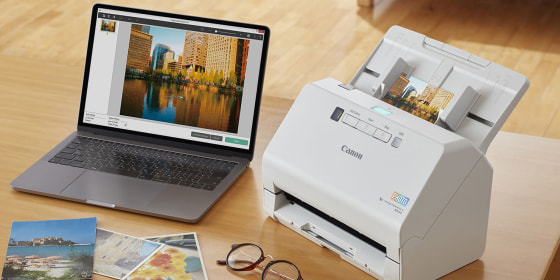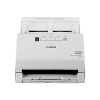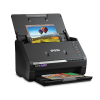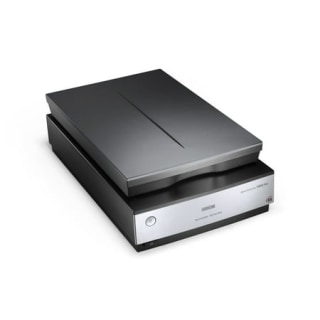You don’t want to leave the fate of your important documents or beloved photographs to chance. Physical objects can degrade over time, fade in the light or suffer water damage, depending on the conditions you keep them in. Photo scanners are an ideal purchase if you want to scan and store your physical memories — ensuring that old pictures, slides and even film negatives are protected in the long term.
Many of the best printers come with some kind of scanning functionality, but usually with office documents in mind. A dedicated photo scanner will be able to digitize high-quality images, ensuring that the detail, color and tone of the original photos are properly recorded. Learn more about what model may be best for you, below.
How we picked the best photo scanners
We spoke with an electronics and photo expert to learn more about photo scanners: how they work, the different kinds available and popular models to consider. Combining his advice with our experience as tech reporters, we kept the following criteria in mind:
- Scanner type: There are a few kinds of photo scanners, but most are considered either a bulk scanner or a flatbed scanner. Bulk scanners look and operate similar to traditional printers — they are fast and hands-off, automatically pulling and scanning material from the built-in tray. Flatbed scanners are the opposite: they are slow and require you to place each page or photo manually, one at a time, but can have much higher-quality scans than a bulk scanner.
- Image quality: When scanning photos, the most important metric is image quality. We looked for models with a decent ppi (pixels per inch) while keeping in mind that not all buyers will want the large file sizes that come with high resolution scans.
- Price: If you’re buying a dedicated photo scanner, rather than an all-in-one printer-scanner-copier, you’re likely paying more for fewer features overall. However, we looked for models at a variety of price points to ensure there was something for every budget.
Want more from NBC Select? Sign up for our newsletter, The Selection, and shop smarter.
The best photo scanners in 2025
Our top picks mostly come from photo brands Epson and Canon, who dominate the photo scanners market, says Mark Steinberg, a senior technologist at B&H Photo & Video. We included a mix of bulk scanners and flatbed scanners, as well as options for hobbyists and professionals. Some of the options scan photos as well as film negatives and documents.
Best multipurpose scanner
If you’re archiving old family photos or documents, an automatic feeding scanner like this one is a great option, says Steinberg. This Canon scanner produces great quality images and can scan about 30 photos in a single minute, according to the brand. It can scan photos, Polaroids and documents (including double sided ones), and automatically download them or send them to cloud services like Google Drive, Dropbox and more.
Best bulk scanner
This scanner is very popular for people with tons of photo prints they want to scan easily and quickly, says Steinberg. It has a sheet tray for documents and photographs, you can stack up to 36 photos or 100 sheets of paper and it will scan each one automatically in one big batch. It can scan a standard photo in just one second, according to the brand. It’s not as detailed as some other options on this list, but the speed and convenience is hard to beat.
Best budget flatbed scanner
For higher quality at a lower price, a flatbed scanner like this one is a good option, says Steinberg. Just know that flatbed scanners are much slower than bulk scanners.
The CanoScan Lide 400 is very slim at 0.4 inches thick, meaning it won’t take up a large amount of space. However, it can still scan various kinds of photos and documents, and it has a very high max resolution of 4,800 dpi to get as much detail as possible out of material.
Best professional scanner
If you’re a professional photographer or artist looking for the best image quality, a CCD scanner like this Epson V850 is best, says Steinberg.
Most scanners are CIS (contact image sensor) scanners, which are small, fast, and affordable to make. A CCD (charge-couple device) scanner is the opposite — larger, slower, and more expensive, but they are often sought out by artists, professionals and archivists because of their superior image quality.
The Epson V850 can scan photo prints, documents and a variety of film negatives, plus it comes with accessories to hold film negatives in place while scanning.
Best film scanner
The OpticFilm 8100 isn’t a flatbed scanner like some others in this list, meaning it lacks a hinged lid or the space needed to scan regular documents. But it can scan 35 millimeter film negatives and slides, allowing you to reproduce images digitally and on a larger scale, from a basic 600 dpi resolution to a high-quality 7,200 dpi. The OpticFilm8100 also comes with a dust-protective bag for easy storage and transport.
FL: https://www.nbcnews.com/select/shopping/best-point-and-shoot-cameras-rcna192819
How to shop for the best photo scanners
If you’re after a photo scanner, it’s important to know what features you need before buying.
Know what type of scanner is right for you
Most photo scanners are either bulk scanners or flatbed scanners, as discussed earlier. Bulk scanners are best for people with a lot of old materials they want scanned: think boxes of family photos or old family recipes sitting in the attic. Bulk scanners work quickly and automatically, but scans can be slightly less detailed than with a flatbed scanner.
Flatbed scanners are best for creatives, artists or anyone looking for the best possible quality scan. You have to place each photo or document individually, one by one, on the scanner, so they are much more time-intensive than using a bulk scanner.
While many models can scan multiple types of photos, documents and images, this isn’t true across the board, especially for more affordable scanners. If you’re looking to scan film negatives or transparent slides, for instance, you’ll need a photo scanner with the correct sensor.
Know how to use the scanner once you get it
You can buy a great scanner and still get so-so results if you don’t know how to use it properly. One of the most common mistakes people make is scanning at too low a resolution for the large prints they want to make, says Steinberg. Scanning at a high resolution is much slower, which can also surprise some new users.
You can learn more about how to use your particular scanner by reading the manual — I also find YouTube tutorials helpful.
Meet our expert
At NBC Select, we work with experts who have specialized knowledge and authority based on relevant training and/or experience. We also take steps to ensure all expert advice and recommendations are made independently and without undisclosed financial conflicts of interest.
- Mark Steinberg is the senior technologist at B&H Photo & Video, a national electronics retailer in New York City. He has decades of experience in electronics sales. (B&H Photo sells hundreds of printers, scanners and cameras — Steinberg does not have affiliations with any individual electronics brand).
Why trust NBC Select?
Henry St. Leger has been a gadget reporter since 2017, covering the latest developments in consumer hardware, including TVs, projectors, gaming consoles and VR headsets. He also reports on games for GamesRadar, The Times and IGN.
Harry Rabinowitz is the tech reporter for NBC Select covering technology and fitness including stories on smartwatches, wireless earbuds and point-and-shoot cameras. He’s been testing new digital cameras (and old film cameras) for years, and prints his photos often. Rabinowitz interviewed a photo and electronics expert to better understand the ins-and-outs of photo scanners and how to shop for the best one for your needs.
Catch up on NBC Select’s in-depth coverage of tech and tools, wellness and more, and follow us on Facebook, Instagram, Twitter and TikTok to stay up to date.












